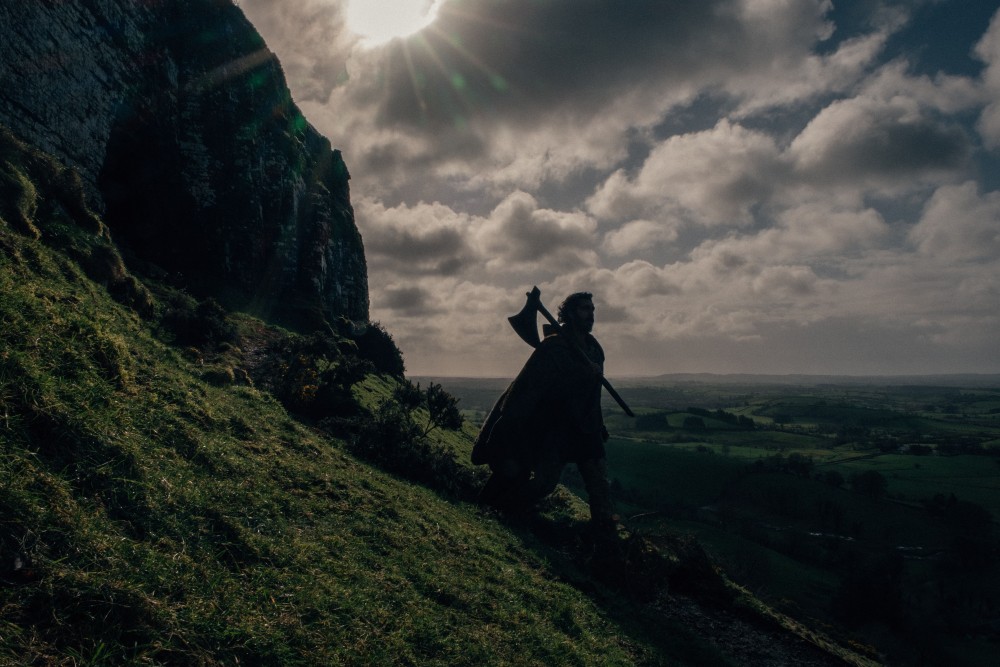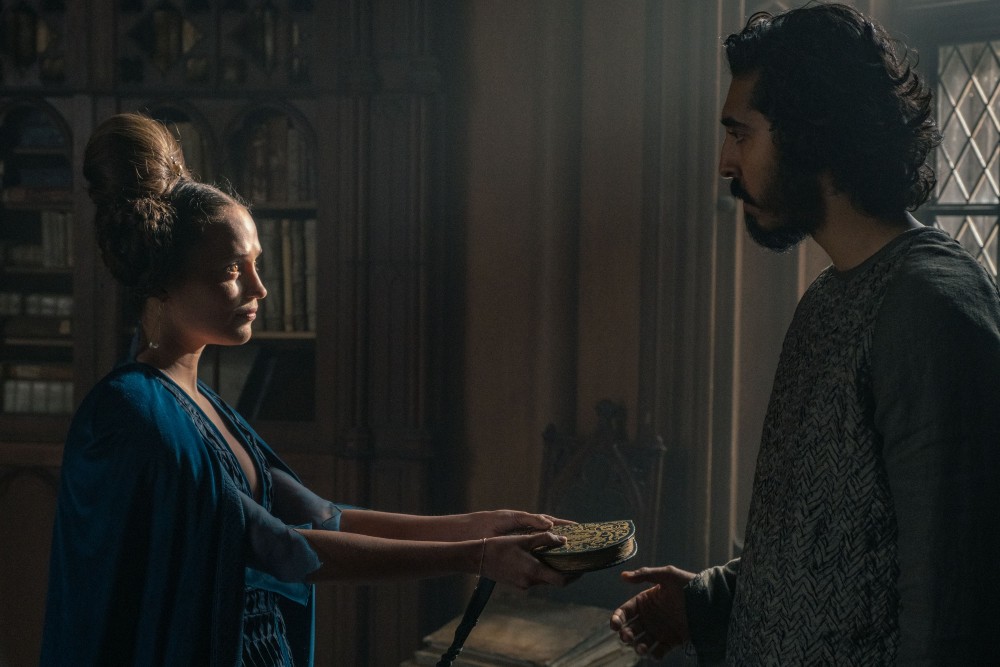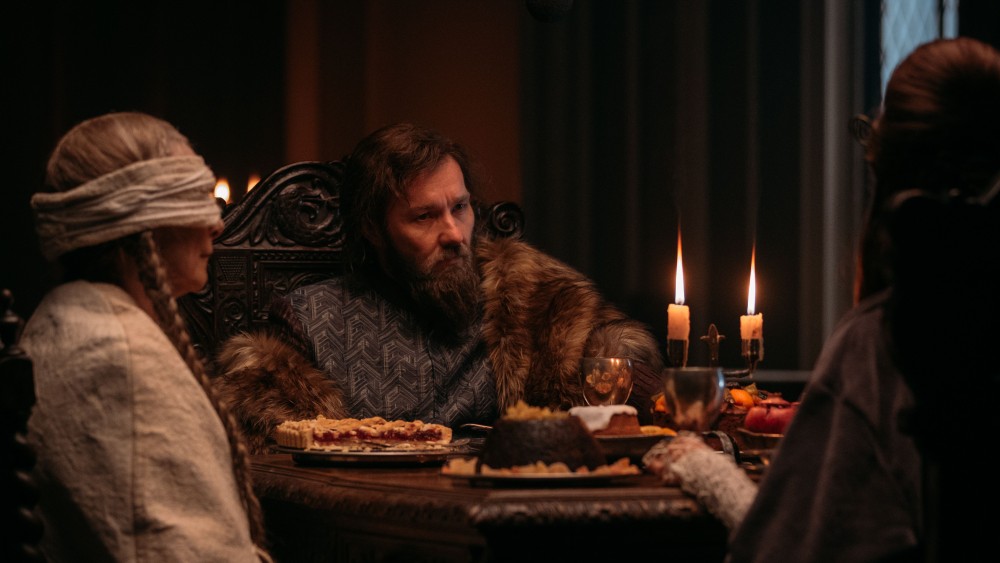
The young boy who sat in the contestant’s chair long ago in Slumdog Millionaire has sure come a long way. For his latest adventure, Dev Patel stars as Sir Gawain in David Lowery’s The Green Knight. This time around, Patel faces a potentially far more dangerous rival across the table, than that which he faced in the 2008 Oscar-winning film. Patel is more than up to the challenge. Maybe it is because both movies contain their fair share of fantastical elements, returning him to a familiar environment. Or maybe he has been that talented all along. Whatever the reason, he and Lowery’s team of dedicated below-the-line crew deliver one of the most surprising and memorable films of the summer.
The Green Knight is based on an Arthurian tale, Sir Gawain and the Green Knight by Anonymous, and was adapted to the screen by Lowery himself. Patel stars as King Arthur’s (Sean Harris) indomitable neighbor, who perhaps somewhat foolishly rises up to a challenge of dubious origin laid down by the titular character (Ralph Ineson). The Knight in question is tree-like, almost Guillermo del Toro style, and is rendered by impressive makeup (led by makeup designer Audrey Doyle) and visual effects to look like a spooky figure from the world of Ichabod Crane. He appears, unannounced, on Christmas Day, when Arthur and his Queen (Kate Dickie) are feasting around their legendary roundtable, and he challenges a worthy opponent to land a blow on his imposing figure. The catch, though, is that the Knight will take his revenge on Christmas Day, one year hence. Why exactly anyone would agree to this is unclear, and this unsettling part of the premise of the movie is perhaps the one element that prevents it from being superb instead of just very good.
Maybe the reason is that Gawain, having just had a morning tryst with his love, Esel (Alicia Vikander), feels valiant. Maybe it has something to do with his mother (Sarita Choudhury) being up to no good while he feasts with Arthur, incanting some mysterious spells that relate to the Knight’s appearance. In any event, once that narrative obstacle is dispensed with, Gawain must face the torture of the year ahead of him, and of his predetermined, chosen fate. He must decide between the honor of facing that destiny with bravery, and, perhaps, living.

Most of the rest of The Green Knight focuses on Gawain’s trek to meet providence, on the internal doubts, fears, and convictions that follow him. Along the way, Gawain encounters some ominous characters (like the forager played by the appropriately creepy Barry Keoghan), and some enticing but potentially dangerous ones, like the mysterious Lady (also played by Vikander) and her Lord (played by Joel Edgerton). Most of the rest of the movie is as mystical as the misty cinematography by Andrew Droz Palermo, as luscious and intricate as the lavish costumes by Malgosia Turzanska. Some of it proceeds almost dreamlike, as Gawain struggles with the internal demons and those that surround him as well, while at times losing grip on reality. The fantasy elements sometimes border on the bizarre, but there is something strangely engrossing about his adventure.
Like all Arthurian tales, The Green Knight is a tale about valor, righteousness, and heroic deeds. It is a tale about bewitching enemies, numinous travails, and inexplicable forces that cannot quite be divided into good and evil. To be effective, any movie that focuses on such complex and ambitious material needs a powerful, even emotional core. The Green Knight finds it in Patel, who gives the most nuanced and arguably best performance of his career. Whereas, before, he had been boyish, playful, and even silly, he has fully grown into his potential. He carries the film, at times broken, many times beaten, but always resolute. His body (which he visibly hardened for the project) tells part of that story, but ultimately it is his ability to convey despair and hope, with his still innocent but more toughened gaze, that makes him most effective. It is no wonder that many characters lust after him, circle around him like vultures, or like moths, and that the Green Knight himself connects with him. Patel as Gawain earns that type of attention.

The Green Knight is arguably also Lowery’s best movie since the one that put him on the map, Ain’t Them Body Saints, now many years ago. Some of the director’s most recent work (think The Old Man and the Gun) had focused on nominally interesting stories that failed to connect emotionally with audiences. This film is interesting—as simple as the premise is—given the peculiarity of the episodes in Gawain’s quest. But it also offers a deeper link to audiences—to care about Gawain because he is so committed to his own doomed destiny, because so many others around him seem honestly to do so as well.
Many tidbits (a stolen kiss from a character, a strange satchel, talking animals) may seem purely symbolic and even overwrought, but the sum total of these elements is something more than just fantastical, something other than just ethereal for its own sake. It is the realization that whatever destiny means, it is not completely written; that whatever resignation to death Gawain may have, it is not completely real. The forces of nature, of others around him, and, of course, of his own actions, still matter, and can alter the course of your fortunes.
All of that is nothing more than the typical, repetitive message that pervades Arthurian legend. But pulling it off in the fantasy world that Lowery and his talented crew of technicians constructed has proven many times quixotic for filmmakers. Not this time, however, because, much like Gawain, the filmmakers seized control of their own lot and improved it for the better.
Grade: A-
A24 will release The Green Knight in North America on July 30, 2021.





